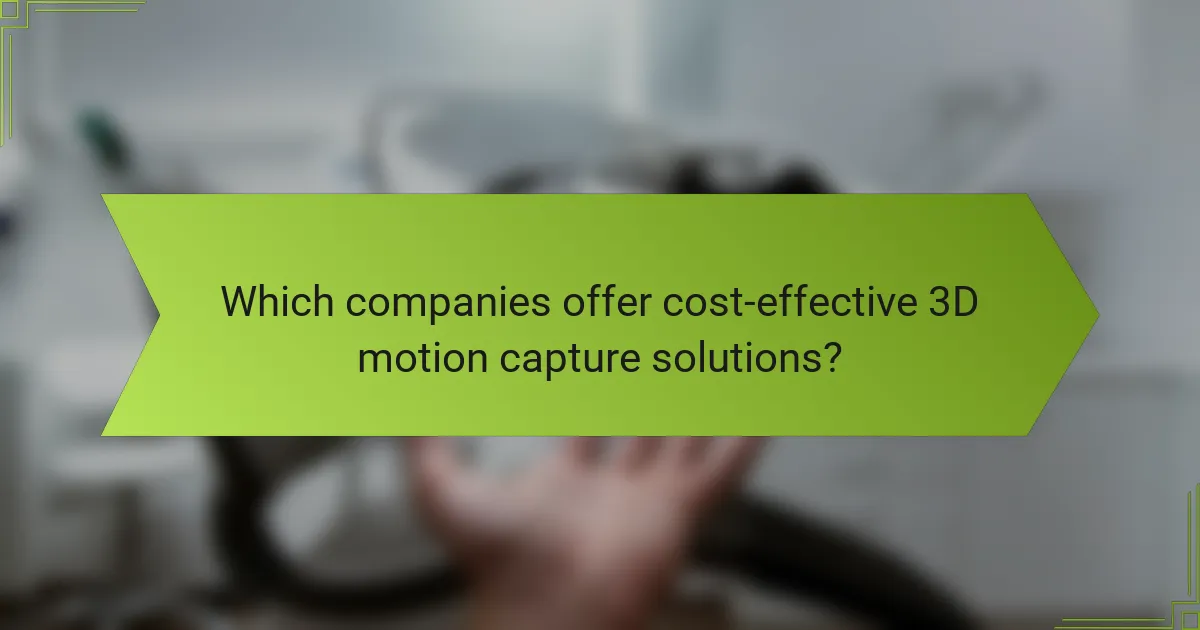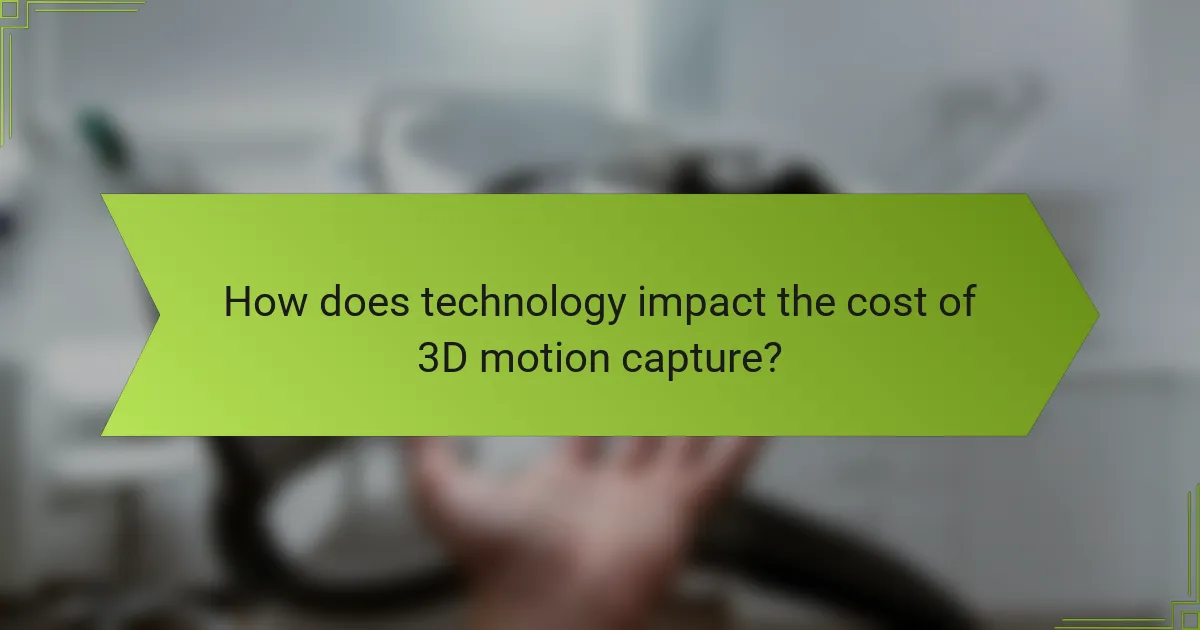In the competitive landscape of 3D motion capture projects, studios in Los Angeles can achieve significant cost savings by embracing innovative technologies and flexible talent solutions. By utilizing cloud services, affordable software, and skilled freelancers, they can deliver high-quality results while effectively managing their budgets. Implementing rigorous testing protocols and investing in quality equipment further ensures that projects maintain their fidelity without compromising on excellence.

How can 3D motion capture projects reduce costs in Los Angeles?
3D motion capture projects in Los Angeles can significantly cut costs by adopting innovative technologies and flexible talent options. By leveraging cloud services, affordable software, and freelance professionals, studios can maintain high-quality outputs while managing their budgets effectively.
Utilizing cloud-based services
Cloud-based services allow studios to access powerful motion capture tools without the need for expensive hardware. This model reduces upfront costs and enables pay-as-you-go pricing, making it easier for smaller projects to get started. Services like Amazon Web Services or Google Cloud can provide scalable solutions tailored to specific project needs.
Additionally, cloud platforms often include collaboration features that facilitate remote work, allowing teams to share and edit motion capture data in real-time. This can lead to faster project turnaround times and lower operational costs.
Investing in affordable software
Choosing cost-effective motion capture software can lead to substantial savings without sacrificing quality. Programs like iPi Soft or Blender offer robust features at a fraction of the price of industry-standard solutions. These tools are often user-friendly, making them accessible for smaller teams or independent creators.
When selecting software, consider the specific needs of your project, such as compatibility with existing systems and the learning curve for your team. Opting for software with a strong community support can also enhance your team’s capability to troubleshoot and innovate.
Leveraging freelance talent
Hiring freelance talent instead of full-time staff can help studios in Los Angeles manage costs effectively. Platforms like Upwork or Fiverr provide access to skilled motion capture artists who can work on a project basis, allowing for flexibility in budgeting and resource allocation.
When engaging freelancers, clearly define project scopes and expectations to avoid misunderstandings. Additionally, consider building a network of reliable freelancers for future projects, which can streamline hiring processes and ensure consistent quality across your work.

What are the best practices for maintaining quality in 3D motion capture?
Maintaining quality in 3D motion capture involves implementing rigorous testing protocols, selecting high-quality equipment, and ensuring staff receive regular training. These practices help to minimize errors and enhance the overall fidelity of motion capture projects.
Implementing rigorous testing protocols
Establishing rigorous testing protocols is essential for identifying potential issues before they affect the final output. This includes conducting pre-capture tests to assess equipment functionality and calibration, as well as post-capture reviews to evaluate data quality. Regularly scheduled tests can help catch problems early, reducing costly rework.
Consider using a checklist for testing, which might include verifying camera alignment, checking sensor accuracy, and ensuring software settings are optimal. This systematic approach can significantly enhance the reliability of your motion capture results.
Choosing high-quality equipment
Selecting high-quality equipment is crucial for achieving accurate motion capture. Invest in reliable cameras, sensors, and software that meet industry standards. While initial costs may be higher, quality equipment often results in better performance and longevity, ultimately saving money in the long run.
When evaluating equipment, look for specifications such as frame rates, resolution, and latency. Brands with a proven track record in the industry can provide the assurance needed for high-quality results. Additionally, consider the compatibility of equipment with existing systems to avoid integration issues.
Regularly training staff
Regular training for staff is vital to ensure they are proficient in using motion capture technology. This includes understanding how to operate equipment, troubleshoot common issues, and utilize software effectively. Well-trained personnel can maximize the potential of the technology and reduce errors during capture sessions.
Consider implementing a training schedule that includes both initial onboarding for new staff and ongoing education for existing employees. Workshops, online courses, and hands-on practice can enhance skills and keep the team updated on the latest advancements in motion capture technology.

Which companies offer cost-effective 3D motion capture solutions?
Several companies provide budget-friendly 3D motion capture solutions without sacrificing quality. These options cater to various project needs, from small indie productions to larger commercial endeavors.
Motion Analysis Corporation
Motion Analysis Corporation specializes in high-performance motion capture systems that are both reliable and cost-effective. Their technology is widely used in sports, animation, and biomechanics, offering a range of solutions that can fit different budgets.
When considering Motion Analysis, evaluate their software compatibility and hardware requirements. They often provide tailored packages that can help reduce costs while maintaining quality, making them a solid choice for diverse applications.
Vicon Motion Systems
Vicon Motion Systems is known for its advanced motion capture technology and user-friendly software. They offer various pricing tiers, which can accommodate both small studios and larger enterprises looking for high-quality results.
Vicon’s systems are particularly noted for their accuracy and ease of integration with other tools. When selecting Vicon, consider their customer support and training resources, as these can significantly enhance the value of your investment.
iPi Soft
iPi Soft provides a unique approach to motion capture with its software-based solutions that utilize standard cameras. This can drastically lower the cost of entry for projects that require motion capture but have limited budgets.
With iPi Soft, users can achieve satisfactory results without the need for expensive hardware. It’s essential to assess the system’s requirements and ensure you have the right camera setup to maximize the software’s capabilities.

What are the key factors to consider when selecting a 3D motion capture provider?
When selecting a 3D motion capture provider, consider budget constraints, project requirements, and the provider’s reputation. Each of these factors plays a crucial role in ensuring that you receive quality services while staying within your financial limits.
Budget constraints
Budget constraints are a primary consideration when choosing a 3D motion capture provider. Costs can vary significantly based on the technology used, the duration of the project, and the complexity of the capture needed. Aim for providers that offer flexible pricing models, such as hourly rates or project-based fees, to find a balance between quality and affordability.
To manage costs effectively, set a clear budget range before engaging with providers. This helps in narrowing down options and prevents overspending. Look for providers who can offer tiered services, allowing you to select only the features you need.
Project requirements
Your project’s specific requirements will heavily influence your choice of a motion capture provider. Consider factors such as the type of motion to be captured, the intended use of the data, and any special needs like real-time processing or integration with other technologies. Clearly outline these requirements in your initial discussions.
For example, if your project involves character animation for video games, you might need a provider with expertise in capturing intricate movements and facial expressions. Ensure that the provider has the necessary equipment and experience to meet your project’s demands.
Provider’s reputation
The reputation of a 3D motion capture provider is a vital factor in your selection process. Research their past projects, client testimonials, and case studies to gauge their reliability and quality of work. A provider with a strong track record is more likely to deliver satisfactory results.
Additionally, consider reaching out to previous clients for firsthand feedback. This can provide insights into the provider’s professionalism, communication skills, and ability to meet deadlines. A reputable provider will often have a portfolio showcasing their work, which can help you assess their capabilities.

How does technology impact the cost of 3D motion capture?
Technology significantly reduces the cost of 3D motion capture by enhancing efficiency and lowering hardware expenses. Innovations in software and hardware allow for high-quality captures at more affordable prices, making this technology accessible to a wider range of projects.
Advancements in software efficiency
Recent advancements in software have streamlined the 3D motion capture process, allowing for faster data processing and improved accuracy. Tools now utilize machine learning algorithms to enhance tracking capabilities, which minimizes the need for extensive manual adjustments.
For instance, software that automates the cleanup of motion data can save hours of editing time, translating to lower labor costs. Many platforms now offer subscription models, enabling studios to access cutting-edge technology without hefty upfront investments.
Reduction in hardware costs
The cost of hardware required for 3D motion capture has decreased significantly due to technological advancements and increased competition. High-quality cameras and sensors that were once prohibitively expensive are now available at a fraction of the cost, making it feasible for smaller studios to invest in this technology.
Additionally, the rise of consumer-grade devices capable of capturing motion data has opened new avenues for budget-conscious projects. For example, using smartphones equipped with advanced cameras can serve as a cost-effective alternative for initial motion capture tests.
